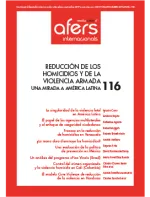The Cure Violence model: violence reduction in San Pedro Sula (Honduras)

Developed in the United States, the Cure Violence model is a programme of epidemic control that reduces violence through changes to norms and behaviour. This article primarily examines the issue of violence in Honduras and, in particular, in San Pedro Sula which was for years the city with the highest homicide rates in the world. To tackle this situation, in 2013 an adapted version of the programme began to be implemented in certain areas of the city. After describing the adaptation of the model to the context of the Honduran city, its results are analysed in two periods of 2014 and 2015 (compared to 2013 and 2014, respectively): a significant reduction in shootings and a minor fall in the homicide figures stand out.
Key words: San Pedro Sula, Honduras, shootings, homicides, health, Cure Violence
Charles Ransford. Coordinador de evaluación, máster en Política Pública; Cure Violence, School of Public Health, University of Illinois at Chicago
R. Brent Decker. Coordinador del Programa para la Prevención de la Violencia, máster en Trabajo Social y Salud Pública; Cure Violence, School of Public Health, University of Illinois at Chicago
Guadalupe M. Cruz. Especialista en asuntos comunitarios sobre «Alto el Fuego»; Cure Violence, School of Public Health, University of Illinois at Chicago
Francisco Sánchez. Cure Violence, School of Public Health, University of Illinois at Chicago
Gary Slutkin. Director ejecutivo, doctor en Medicina; Cure Violence, School of Public Health, University of Illinois at Chicago
DOI: doi.org/10.24241/rcai.2017.116.2.179
>> The full text articles of this issue are available only in Spanish language